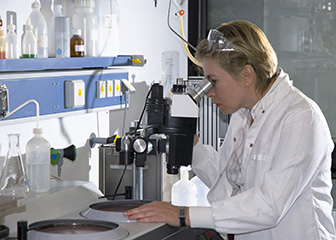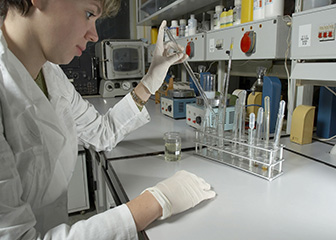What Chemists and Materials Scientists Do
About this section

Most chemists and materials scientists work as part of a team.
Chemists and materials scientists study the structures, compositions, reactions, and other properties of substances. They use their knowledge to develop new and improved products, processes, and materials.
Duties
Chemists and materials scientists typically do the following:
- Plan and carry out complex research projects, such as the development of new products, processes, and testing methods
- Direct technicians and other workers in testing procedures to analyze components and physical properties of materials
- Instruct scientists and technicians on proper chemical processing and testing procedures, such as ingredients, mixing times, and operating temperatures
- Prepare test solutions, compounds, and reagents (such as acids) used in laboratory procedures
- Analyze substances to determine their chemical and physical properties, such as their structure and composition
- Conduct tests on materials and other substances to ensure that safety and quality standards are met
- Write technical reports that detail methods and findings
- Present research findings to scientists, engineers, and other colleagues
Many chemists and materials scientists work in basic and applied research. In basic research, chemists investigate the properties, composition, and structure of matter. They also experiment with the laws that govern the combination of elements and reactions of substances to each other.
In applied research, chemists create new products and processes or improve existing ones, often using knowledge gained from basic research. Chemistry research has led to the discovery and development of new and improved drugs, plastics, cleaners, and thousands of other products.
Almost all materials scientists work in applied research. They study the structures and chemical properties of various materials to develop new products or enhance existing ones. They also determine ways to strengthen or combine materials or develop new materials for use in a variety of products. Applications of materials science include superconducting materials, ceramics, and metallic alloys.
Chemists and materials scientists use computers and a wide variety of sophisticated laboratory instrumentation for modeling, simulation, and experimental analysis. For example, some chemists use three-dimensional (3D) computer modeling software to study the structure and other properties of complex molecules that they make.
Most chemists and materials scientists work as part of a team. An increasing number of scientific research projects involve multiple disciplines, and it is common for chemists and materials scientists to work on teams with other scientists, such as biologists and physicists, computer specialists, and engineers. For example, in pharmaceutical research, chemists may work with biologists to develop new drugs and with engineers to design ways to mass produce them. For more information, see the profiles on biochemists and biophysicists, microbiologists, zoologists and wildlife biologists, physicists and astronomers, computer and information technology occupations, and engineers.
Chemists often specialize in a particular branch of the field. The following are examples of some types of chemists:
Analytical chemists determine the structure, composition, and nature of substances by examining and identifying their various elements or compounds. They also study the relationships and interactions between the parts of compounds and develop new techniques for carrying out their work. Their research has a wide range of applications, including food safety, pharmaceuticals, and pollution control.
Inorganic chemists study the structure, properties, and reactions of molecules that do not contain carbon, such as metals. They work to understand the behavior and the characteristics of inorganic substances. Inorganic chemists figure out how these materials can be modified, separated, or used in products, such as ceramics and superconductors.
Medicinal chemists research and develop chemical compounds that can be used as pharmaceutical drugs. They work on teams with other scientists and engineers to create and test new drug products. They also help develop new and improved manufacturing processes to produce new drugs on a large scale effectively.
Organic chemists study the structure, properties, and reactions of molecules that contain carbon. They also design and make new organic substances that have unique properties and applications. These compounds have, in turn, been used to develop many commercial products, such as pharmaceutical drugs and plastics.
Physical chemists study the fundamental characteristics of how matter behaves on a molecular and atomic level and how chemical reactions occur. Based on their analyses, physical chemists may develop new theories, such as how complex structures are formed. Physical chemists often work closely with materials scientists to research and develop potential uses for new materials.
A growing numbers of chemists work in interdisciplinary fields, such as biochemistry and geochemistry. For more information, see the profiles on biochemists and biophysicists and geoscientists.
Many people with a chemistry background become professors or teachers. For more information, see the profiles on high school teachers and postsecondary teachers.














